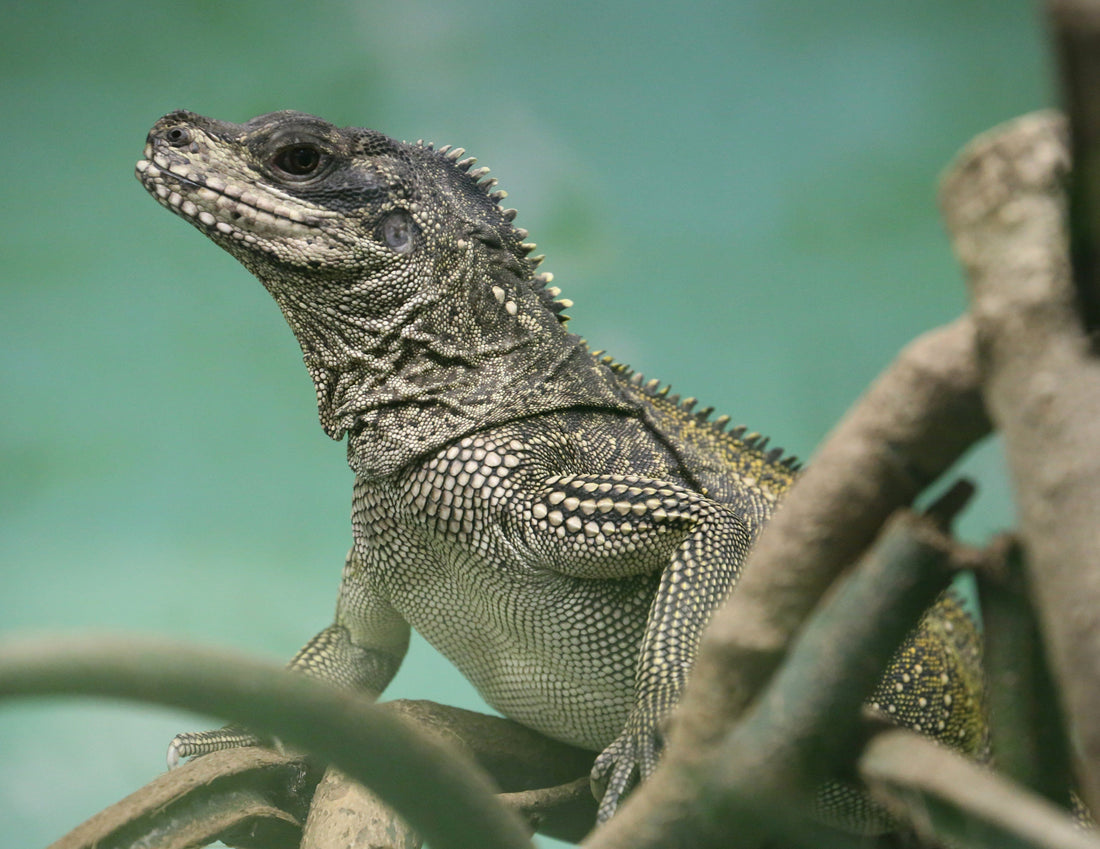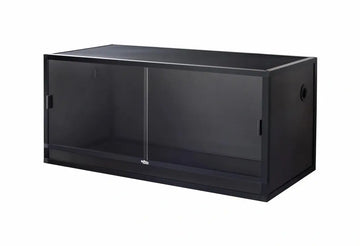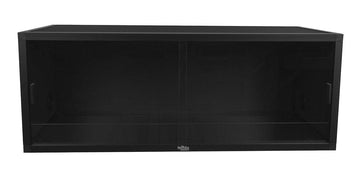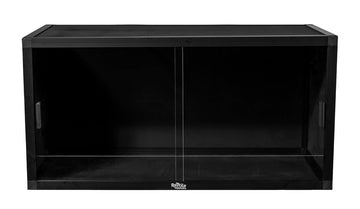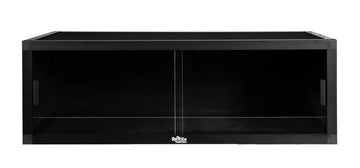Sailfin dragons (Hydrosaurus sp.) are large, diurnal, arboreal lizards native to Indonesia and the Philippines. They prefer a tropical rainforest habitat near freshwater lakes and streams.
Sailfin dragons are striking reptiles with a green or brown base color with blue, purple, and/or gold markings. They have large eyes, a bulbous snout, a large sail-like crest on their tail, and a smaller row of spikes down the length of their spine. Females are typically plainer than males.
Sailfin dragons are not easy animals to keep as pets, despite their availability in the pet trade. They’re fairly large, require a spacious enclosure with specialized equipment, and don’t tolerate poor husbandry well. However, properly housed, they can make a wonderful display species. With good care, a sailfin dragon can live up to 25 years.
Minimum terrarium size for sailfin dragons
The absolute minimum enclosure size for a single sailfin dragon is 6’L x 3’W x 6’H. This may seem huge, but keep in mind that these are large lizards that need opportunities for both climbing and swimming within their enclosure. Of course, if you can manage it, larger is always better!
Housing multiple sailfin dragons in the same enclosure is not recommended.
Do sailfin dragons need UVB?
Yes! Sailfin dragons require UVB lighting for their survival. UVB lighting helps provide a clear day/night cycle, provides all of the vitamin D that your pet needs, strengthens the immune system, facilitates better digestion, and other benefits.
Here are the best UVB bulbs for sailfin dragons housed in a 6’L x 3’W x 6’H enclosure:
- Arcadia Desert 12%, 34”
- Zoo Med Reptisun T5 HO 10.0, 34”
For best results, house the UVB bulbs in a reflective fixture. Position the lamp on the same side of the terrarium as the heat lamp. If the UVB is mounted over mesh, place the basking branch so the lizard’s head is 11-12” below the lamp. If the UVB is mounted inside the enclosure, place the basking branch so the lizard’s head is 18-20” below the lamp.
They are also likely to benefit from plant grow lights as part of their environment as well. Add a ~6500K LED or T5 HO fluorescent grow lamp to provide extra illumination, as well as help any live plants in the enclosure to thrive.
Lights should be on for 12 hours/day.
Best temperature for sailfin dragons
Sailfin dragons need a basking surface temperature between 110-120°F, and average ambient temperatures between 80-90°F. Temperatures can drop down to 70°F at night. Measure your enclosure temperatures with a temp gun.
Provide heat for your dragon with a cluster of halogen heat bulbs placed above the basking branch. You will need enough lamps to evenly heat an area at least the size of the lizard’s body. Halogen bulbs are the best way to imitate the warmth of sunlight indoors, and considered to be a superior form of reptile heating by experts. Do not use ceramic heat emitters (CHEs), red bulbs, or blue bulbs, as these are not as effective. Radiant heat panels, however, can be helpful as a secondary heat source for maintaining warm air temperatures.
Best humidity levels for sailfin dragons
Sailfin dragons are a tropical species, so the humidity inside their enclosure should be fairly high: 60-80% on average. Humidity should be measured via digital probe hygrometer, with the probe placed in the middle of the terrarium.
Increase humidity by misting your dragon’s enclosure 2x/day with a large pressure sprayer or automatic misting system. Mist in the morning and at night, preferably when the lights are off. If you need more help maintaining humidity, install a cool mist humidifier connected to a humidistat to run at night.
Sailfin dragons are very comfortable around the water, so it’s best to provide a pool of water that is deep and large enough for them to dive into and swim around in. This means that it should be at least 12” deep, and occupy 1/2 to 1/3 of the enclosure’s floor space.
Your dragon’s pool water will need to be changed once weekly or whenever it gets spoiled. Give the pool a good scrub with disinfectant before refilling. Using a siphon (or better yet, a powerful mechanical water pump) and a hose will make maintaining your lizard’s pool faster and easier
Best substrate for sailfin dragons
Although sailfin dragons spend most of their time either in the trees or in their pool, they do occasionally spend time at ground level. Providing a layer of naturalistic substrate (“bedding”) in the enclosure will help maintain correct humidity, cushion your lizard against falls, provide a digging medium, and also help make your enclosure more attractive!
We recommend the following substrates for sailfin dragons:
Layering clean, chemical-free leaf litter on top of the substrate can help with humidity as well as add enrichment value.
Substrate should be at least 4” deep and completely replaced every 3-4 months. Remove poop and urates daily, along with any contaminated substrate.
How to decorate a sailfin dragon terrarium
An empty enclosure makes for a bored sailfin dragon, reducing its quality of life. Keep your pet entertained and engaged with its environment with the strategic use of décor items that encourage it to exercise natural behaviors!
Since sailfin dragons prefer to spend their time either in the trees or in the water, at bare minimum you will need a large, sturdy branch for them to bask on and a sufficiently large pool for swimming. However, it’s best to include other items, such as:
- hideouts/caves
- more branches
- ledges
- live or artificial foliage
All climbing branches should be securely anchored into the walls/floor of the enclosure to prevent collapse.
Training and designing enrichment activities are also good ways to help keep your sailfin dragon engaged, as well as provide a nice opportunity for bonding!
What to feed to a sailfin dragon
Sailfin dragons are omnivores. When they’re young and growing, they require a diet of 75% protein and 25% vegetables, but when they’re adults this changes to 50% protein and 50% vegetables.
Feeder insects for sailfin dragons: crickets, discoid roaches, dubia roaches, earthworms, grasshoppers, hornworms, silkworms, mealworms, superworms, snails (captive-bred only)
Other protein options for sailfin dragons: mice, small rats, fish, crayfish, shrimp, scrambled eggs (no oil or salt), organ meat
Vegetables for sailfin dragons: collard greens, cactus pads, spring mix, arugula, kale, alfalfa, bok choy, carrot greens, spinach, dandelion greens/flowers, hibiscus greens/flowers
Fruits such as bananas, berries, kiwi, grapes, melons, papaya, and mango are good to use as treats.
Supplements
You will also need calcium and vitamin supplements to help keep your dragon healthy. We recommend Repashy Calcium Plus LoD, lightly dusted on all insects and meats. It’s okay to occasionally skip a dusting.
How to handle your sailfin dragon
Reptiles generally don’t appreciate petting and handling in the same way that dogs and cats do. Regarding sailfin dragons specifically, they generally prefer to be left alone, although some learn to tolerate human interaction well.
If you want to build a trusting relationship with your pet, you will need to develop a foundation of positive interactions. Offering food from feeding tweezers works well as an initial bribe, and it’s best to get the lizard to come to you rather than simply grabbing it.
Here are some more tips for success:
- Don’t grab the lizard from above. Instead, scoop from below.
- Support as much of its body as possible.
- Start with short handling sessions at first, then gradually make them longer.
- Put the lizard back in its enclosure only when it’s calm.
*This care sheet contains only very basic information. Although it’s a good introduction, please further your research with high-quality sources. The more you know, the better you will be able to care for your pet!
"File:Molukkensegelechse Hydrosaurus weberi Zoo Augsburg-01.jpg" by Rufus46 is licensed under CC BY-SA 3.0

